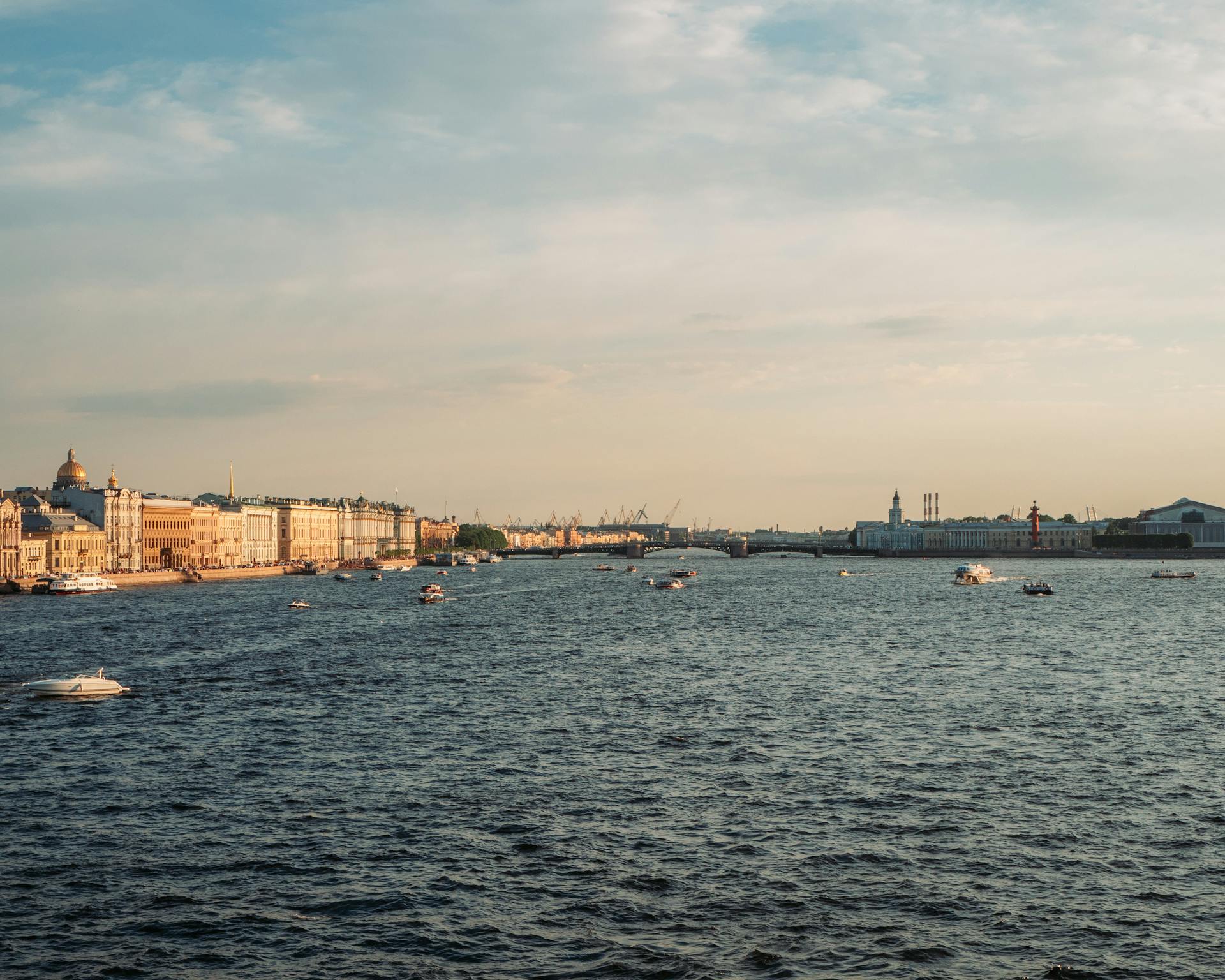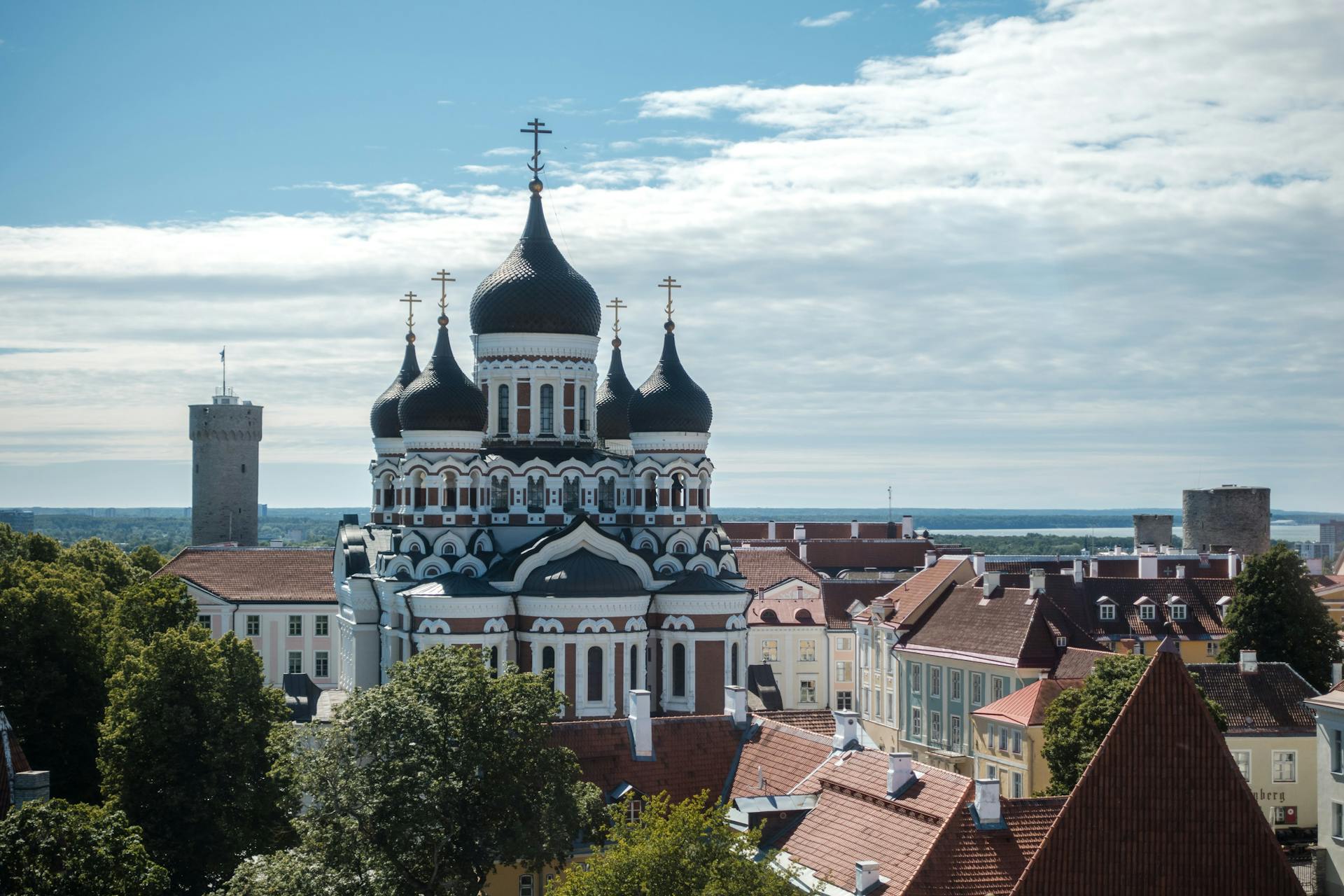
The Port of St. Petersburg is a vital part of the city's economy, handling over 40 million tons of cargo annually.
The port's strategic location on the Baltic Sea makes it an ideal hub for global trade.
The port's cargo capacity is impressive, with the ability to handle container ships, bulk carriers, and general cargo vessels.
The port's importance extends beyond just cargo, with over 20,000 people employed in the port's operations and related industries.
Port Operations
The Port of St. Petersburg is a major cargo hub, handling a wide range of goods including oil products, metals, and forest products. In 2016, the cargo turnover in the port was 7.5 million tons.
The main stevedoring companies operating in the port are responsible for unloading and loading cargo from ships. These companies include the Sea Port of St. Petersburg, NEVA-METAL, Baltic Bulk Terminal, Moby Dick, LLC, St. Petersburg Petroleum Terminal, First Container Terminal, and Petrolesport.
The Sea Port of St. Petersburg handled 7 million tons of cargo in 2020, while NEVA-METAL specializes in transshipping containers and general cargoes. Baltic Bulk Terminal is a universal transshipment complex for mineral fertilizers, handling both sea and train-borne cargo.
Operations
The Port of St. Petersburg is a bustling hub of activity, with a wide range of cargo being loaded and unloaded every day. The port handles oil products, metals, forest products, containers, coal, ore, chemical cargoes, and scrap metal.
The main stevedoring companies operating in the port are the Sea Port of St. Petersburg, NEVA-METALL, Baltic Bulker Terminal, Moby Dick LLC, St. Petersburg Petroleum Terminal, First Container Terminal, and Petrolesport. These companies play a crucial role in ensuring that cargo reaches its intended destination.
In 2020, the Sea Port of St. Petersburg handled 7 million tons of cargo, while NEVA-METALL specializes in the transshipment of containers and general cargoes, handling over 3 million tons annually. Baltic Bulk Terminal is a universal transshipment complex for mineral fertilizers, housing cargoes that arrive from both sea vessels and trains.
The port's cargo turnover in January-February 2016 was 7.5 million tons, down 7.0% compared to the same period in 2015. Despite this decline, the port's stevedoring companies have remained operational, even during the Coronavirus pandemic.

Here's a breakdown of the main stevedoring companies operating in the port:
Recent Ship Departures
The Port of Saint Petersburg has been bustling with activity, with numerous ships departing in the past 24 hours. One of the earliest departures was the GRIFON-7 Pusher Tug, which left the port at 21:38 on April 23.
The GRIFON-7 is a relatively new vessel, built in 2008. It's also one of the larger tugboats in the port, measuring 26 meters in length.
Another notable departure was the ANTEY Passenger/Ro-Ro Cargo Ship, which left the port at 21:28 on April 23. This ship is a veteran of the port, built in 1988 and measuring 191 meters in length.
Here are some of the recent ship departures from the Port of Saint Petersburg:
The Port of Saint Petersburg is a major hub for international trade, and these ship departures are just a small sample of the many vessels that pass through the port every day.
Size Inquiry
The Port of St. Petersburg is a massive operation, and its size is a key factor in its ability to handle cargo from around the world.
The total quay length of the port is 1,058 meters, or 3,537 feet, which is a significant amount of space for ships to dock and unload their cargo.
The operational berthing distance is 780 meters, or 2,559 feet, which is the distance from the port's edge to where ships can actually dock.
This vast space allows the port to accommodate a wide range of vessels, from small cargo ships to large container carriers.
Port History and Management
The Port of St. Petersburg has been managed by the Port Authority of St. Petersburg since 2011.
The Port Authority is responsible for overseeing commercial navigation in the port as well as managing operations that expand beyond the boundaries of the Russian Federation’s jurisdiction.
The Port of St. Petersburg has a rich history, with the necessity for a new passenger terminal caused by the inability of the existing Marine Terminal to accommodate cruise ships longer than 200 meters.

Construction of the marine passenger terminal began in 2005, with the signing of a government order by Russian Prime Minister Mikhail Fradkov.
By 2007, the educational sailing vessel Young Baltiets was moored at berth number seven, marking a significant milestone in the development of the port.
Here is a brief overview of the port building schedule:
History
The Port of St. Petersburg has a rich history dating back to 1703 when Peter the Great laid the foundation stones for the Peter-Paul Fortress.
Peter the Great's vision for the port was to establish a direct water route to the Volga River basin and central Russia, which was completed by 1709.
The port's development continued throughout the 1800s, with new railroads and a modernized canal system being built, leading to a population of 1.5 million by 1900.
Worker uprisings during the early 20th century culminated in a general strike in 1905, which led to the Bloody Sunday massacre and eventually the Russian Revolution.
By the 1940s, the Port of St. Petersburg produced just 11% of the nation's output, and the population had fallen to around 3 million.
In the 2000s, the port underwent significant development, with a new passenger terminal being built to accommodate larger cruise ships.
The Marine Facade Company built 35 hectares of reclaimed land, a technological channel, and other necessary structures for the new terminal, which was completed in 2011.
Here's a brief breakdown of the port building schedule:
The port's development has had a significant impact on the city's economy and population, and it continues to be an important hub for trade and tourism.
Who Manages the?
The Port of St. Petersburg has been managed by the Port Authority of St. Petersburg since 2011. This organization is responsible for overseeing commercial navigation in the port.
The Port Authority is in charge of managing operations that expand beyond the Russian Federation's jurisdiction. This includes handling tasks that go beyond the country's borders.
The Port Authority has been successfully managing the port for over a decade, ensuring its operations run smoothly.
Port Capabilities and Services
The Port of St. Petersburg offers a wide range of capabilities and services that make it an essential hub for global trade. With a workforce of nearly 2,000 employees, the port is able to handle a massive amount of cargo.
Some of the goods that ship from the Port of St. Petersburg include coal, metals, forest products, ore, chemicals, and oil products. These goods are then shipped off to destinations around the world.
The port's throughput has seen significant improvement in recent years, with 51.75 million tons of cargo handled in the first six months of 2021 alone. This is a testament to the port's efficiency and capabilities.
The port's reach extends to various regions, including South-East Asia, Far-East Asia, and Eastern European nations like Belarus and Estonia. This gives shippers local to St. Petersburg access to foreign markets.
Here are some of the goods that travel through the Port of St. Petersburg:
- Mineral fertilizers
- Grain
- Timber
- Fish
Port Infrastructure and Support

The Port of St. Petersburg has a diverse range of vessels that travel through it, including bulk carriers, container ships, reefer vessels, and oil/chemical tankers.
This variety is impressive, and it's a testament to the port's ability to handle different types of cargo and vessels.
The port manages its own fleet, which consists of tugboats, ice breakers, pilotage boats, and a fire vessel.
This fleet is essential for ensuring the safe and efficient operation of the port, and it's a key factor in the port's ability to support a wide range of vessels.
The Port of St. Petersburg's ability to support multiple types of vessels sets it apart from other ports that are container-only.
Port Trends and Statistics
The Port of St. Petersburg is a major economic driver, with cargo volumes increasing by 12% in 2020 compared to the previous year.
The port's container terminal handled over 1.1 million twenty-foot equivalent units (TEUs) in 2020, making it one of the busiest container ports in the country.

In 2020, the port's cargo turnover reached 25.5 million tons, a significant increase from 2019.
The port's cargo mix is dominated by bulk cargo, including coal, iron ore, and grain, which accounted for 70% of the total cargo volume in 2020.
The port's container terminal has a capacity of 1.2 million TEUs per year, with a planned expansion to 1.5 million TEUs by 2025.
In 2020, the port handled over 200,000 passengers, making it one of the busiest passenger ports in the region.
The port's cargo turnover is expected to continue growing, with a projected increase of 10% in 2021.
Port Location and Tourism
The Port of St. Petersburg is located in a way that can make it a bit tricky to get around. Small cruise ships can dock close to the city center at English Embankment or Lieutenant Schmidt Embankment, but larger ships have to dock at the Marine Façade, a brand new facility with 8 berths and 4 identical terminals.
Getting to the city center from the Marine Façade is relatively easy, though. You can take the local bus #158, which runs every half an hour, to the nearest metro station Primorskaya, where you can transfer to the metro and head to the city center.
Location

The Port of St. Petersburg is located near the Neva River Delta in the Nevsky Lip of the Gulf of Finland, which takes up the eastern section of the Baltic Sea.
Only small cruise ships can dock close to the city center at either English Embankment or Lieutenant Schmidt Embankment. All other ships dock at Marine Façade, a brand new facility with 8 berths and 4 identical terminals.
The Marine Façade is a bit far outside urbanity, but you can take a local bus #158, which runs every half an hour, to the nearest metro station Primorskaya for a few rubles.
Once you go through customs, you'll find a few souvenir stands and a coffee counter that only accepts credit cards. There's also a local bus #158 that can take you to the nearest metro station.
Getting into Russia is relatively easy if you're on a cruise or organized group, and you only need to carry your passport and excursion ticket. However, if you want to do independent touring, you'll need a Visa, which can be a costly and time-consuming process.
Sightseeing:

Sightseeing in Saint Petersburg can be a challenge due to the heavy traffic, especially when one of the Neva bridges is under repair.
You may find that your tour doesn't show you everything that was promised, which can be frustrating.
Traffic in Saint Petersburg is very heavy, so be prepared for delays.
Frequently Asked Questions
Is there a cruise Port in St. Petersburg, Florida?
Yes, Port St. Pete is a cruise port located in downtown St. Petersburg, Florida, offering access to local amenities and attractions.
Sources
- https://en.wikipedia.org/wiki/Great_Port_of_Saint_Petersburg
- https://www.vesselfinder.com/ports/RULED001
- https://spire.com/blog/maritime/the-port-of-st-petersburg-and-its-impact-on-global-trade/
- https://www.whatsinport.com/Saint-Petersburg.htm
- https://www.wikiwand.com/en/articles/Passenger_Port_of_St._Petersburg
Featured Images: pexels.com

